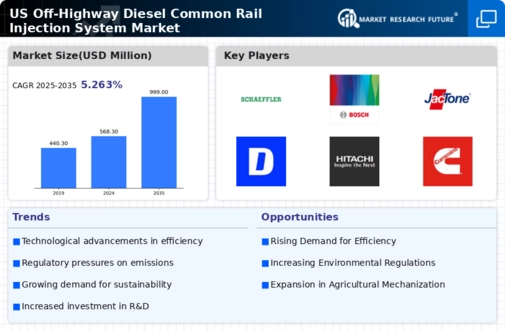Expansion of Infrastructure Projects
The off highway-diesel-common-rail-injection-system market is poised for growth due to the expansion of infrastructure projects across the United States. Government initiatives aimed at improving transportation networks and public facilities are driving demand for heavy machinery and equipment that utilize diesel engines. This surge in infrastructure spending is anticipated to increase the need for efficient and reliable off highway vehicles, which in turn boosts the demand for advanced common rail injection systems. With an estimated investment of $1 trillion in infrastructure over the next decade, the off highway-diesel-common-rail-injection-system market is likely to benefit significantly from this trend, as manufacturers strive to meet the growing requirements of the construction and transportation sectors.
Increasing Fuel Efficiency Requirements
The off highway-diesel-common-rail-injection-system market is experiencing a notable shift due to increasing fuel efficiency requirements imposed by regulatory bodies. These mandates are compelling manufacturers to innovate and enhance their diesel engines, leading to the adoption of advanced common rail injection systems. As a result, the market is projected to grow at a CAGR of approximately 5.5% over the next five years. This growth is driven by the need for improved fuel economy, which not only reduces operational costs for end-users but also aligns with environmental sustainability goals. Consequently, manufacturers are investing in research and development to create systems that meet these stringent efficiency standards, thereby propelling the off highway-diesel-common-rail-injection-system market forward.
Rising Adoption of Emission Control Technologies
The off highway-diesel-common-rail-injection-system market is significantly influenced by the rising adoption of emission control technologies. As environmental regulations become more stringent, there is a growing necessity for diesel engines to comply with lower emission standards. This trend is particularly evident in the construction and agricultural sectors, where equipment must meet specific emission criteria. The integration of advanced common rail injection systems facilitates better combustion efficiency, leading to reduced NOx and particulate matter emissions. The market is expected to witness a growth rate of around 6% as manufacturers increasingly incorporate these technologies into their designs, thereby enhancing the competitiveness of the off highway-diesel-common-rail-injection-system market.
Technological Integration in Agricultural Equipment
The off highway-diesel-common-rail-injection-system market is being shaped by the technological integration in agricultural equipment. As the agriculture sector increasingly adopts precision farming techniques, there is a heightened demand for advanced machinery that can operate efficiently under varying conditions. Common rail injection systems are becoming essential in modern agricultural equipment, providing better fuel efficiency and performance. This trend is expected to drive the market growth at a rate of approximately 4.5% as farmers seek to optimize their operations and reduce costs. The off highway-diesel-common-rail-injection-system market is thus likely to see a surge in demand as manufacturers respond to the evolving needs of the agricultural industry.
Shift Towards Electrification of Off Highway Vehicles
The off highway-diesel-common-rail-injection-system market is currently facing a shift towards the electrification of off highway vehicles. While diesel engines have long been the standard, there is a growing interest in hybrid and fully electric alternatives. This transition is driven by the need for reduced emissions and lower operating costs. However, diesel engines equipped with common rail injection systems still play a crucial role in this transition, as they provide the necessary power and efficiency for heavy-duty applications. The market is expected to adapt by integrating hybrid technologies, which may lead to a more competitive landscape. This evolution could potentially reshape the off highway-diesel-common-rail-injection-system market as manufacturers explore innovative solutions to meet changing consumer preferences.























Leave a Comment